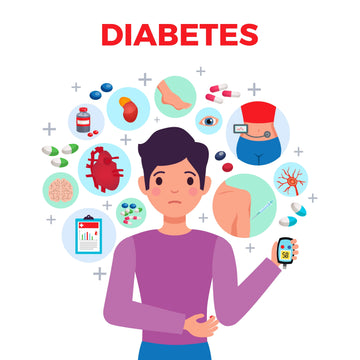The most important step in taking control of your health is recognizing diabetes symptoms at the right time. Millions of people worldwide live with diabetes, and many do not even know it until serious problems appear. Learning about diabetes symptoms, understanding what diabetes is, and exploring different types of diabetes helps you or your loved ones stay healthy and avoid long-term complications.
What is Diabetes and Why Should You Care?
If you have ever asked yourself, what is diabetes, the answer is simple but serious. Diabetes is a medical condition that affects the way your body processes sugar, also known as glucose. Normally, insulin, a hormone made by the pancreas, helps move sugar from food into your cells where it is used for energy. When your body does not make enough insulin, or cannot use it properly, sugar stays in the blood.
Understanding ‘what is diabetes’ is the foundation for prevention and treatment. Without care, high blood sugar can damage the eyes, heart, kidneys, nerves, and more. But the good news is, with the right knowledge, lifestyle choices, and treatment plans, you can live a full and healthy life.
Types of Diabetes and How They Differ
There are three main types of diabetes that affect people in different ways.
-
Type 1 Diabetes – An autoimmune disease where the immune system mistakenly attacks insulin-producing cells. People with this condition need insulin every day.
-
Type 2 Diabetes – The most common form, usually linked to poor diet, lack of exercise, or genetics. Here, the body becomes resistant to insulin or does not make enough.
-
Gestational Diabetes – This appears during pregnancy and usually goes away after delivery. However, it raises the risk of developing type 2 later in life.
Knowing the types of diabetes helps you understand treatment approaches. For example, insulin is essential in type 1, while lifestyle changes are the first line of defense in type 2.
Common Diabetes Symptoms You Must Watch Out For
Recognizing diabetes symptoms early can make all the difference. The most common signs include these of the following diabetes symptoms.
-
Excessive thirst and frequent urination
-
Sudden weight loss or gain
-
Extreme fatigue and low energy
-
Blurry vision
-
Increased hunger
-
Slow-healing wounds or infections
If you notice these diabetes symptoms, it is wise to get a blood test to check your diabetes range and consult a doctor immediately.
Comparing Type 1 and Type 2 Diabetes
Many people confuse the differences between type 1 and type 2 diabetes. Both involve high blood sugar but they are not the same. Type 1 and type 2 diabetes vary in cause, treatment, and management.
-
Type 1 usually develops in children or young adults, it is not linked to lifestyle, and always needs insulin.
-
Type 2 often develops later in life, is linked to weight, inactivity, and poor diet, and can sometimes be controlled without insulin at first.
By understanding type 1 and type 2 diabetes, patients can make informed choices and avoid misconceptions.
Knowing Your Diabetes Range
Monitoring blood sugar is essential. Doctors use numbers called the diabetes range to diagnose and track the condition.
-
Normal fasting glucose: 70–99 mg/dL
-
Prediabetes: 100–125 mg/dL
-
Diabetes: 126 mg/dL or higher
Staying within the healthy diabetes range is the goal of all treatments, whether through medicine, insulin, or lifestyle changes.
Causes and Risk Factors of Diabetes
The causes vary depending on the types of diabetes. Type 1 is caused by the immune system destroying insulin cells. Type 2 is often caused by obesity, poor diet, family history, and lack of activity. Gestational diabetes comes from hormonal changes during pregnancy.
Risk factors include these of the following signs.
-
Family history
-
High blood pressure
-
High cholesterol
-
Being overweight
-
Sedentary lifestyle
Knowing these risk factors helps you reduce your chances of facing serious diabetes symptoms.
Treatments and the Truth About Curing Diabetes
When it comes to curing diabetes, the truth is complicated. Right now, there is no permanent cure. However, there are many ways to manage and sometimes even reverse symptoms in type 2.
-
Medications – Pills or insulin injections keep sugar under control.
-
Diet changes – Eating whole foods, fewer sugars, and more fiber helps stabilize blood sugar.
-
Exercise – Daily movement improves insulin sensitivity.
-
Monitoring – Regular testing ensures you stay in a safe diabetes range.
Although curing diabetes fully is not possible today, many people with type 2 can live without medication if they adopt healthy habits.
Lifestyle Tips for Managing Diabetes Symptoms
Managing diabetes symptoms is about consistency. Small daily habits matter, which can be included in these forums.
-
Drink enough water
-
Avoid sugary drinks and processed foods
-
Sleep well
-
Check your sugar levels regularly
-
Stay active
By combining these habits with treatment, you can reduce complications and enjoy life.
Final Thoughts
Diabetes is more than just numbers on a test. It is about awareness, action, and adaptation. Understanding what diabetes is, knowing the types of diabetes, spotting diabetes symptoms, and staying within the right diabetes range all give you power over the condition. While science is still working on curing diabetes, your choices today shape your tomorrow.
FAQs
Q1: What are the most common diabetes symptoms?
A: Common diabetes symptoms include excessive thirst, urination, fatigue, and blurry vision.
Q2: What is diabetes in simple words?
A: Diabetes is a condition where the body cannot properly use or make insulin, causing high blood sugar.
Q3: What are the main types of diabetes?
A: There are three types of diabetes: type 1, type 2, and gestational.
Q4: What is the difference between type 1 and type 2 diabetes?
A: Type 1 and type 2 diabetes differ because type 1 always needs insulin, while type 2 may be managed with diet and medicine.
Q5: What is the healthy diabetes range?
A: A healthy fasting diabetes range is between 70 and 99 mg/dL.
Q6: Can diabetes be cured permanently?
A: Complete curing diabetes is not possible yet, but type 2 can sometimes go into remission.
Q7: What causes diabetes?
A: Causes include genetics, lifestyle, immune system problems, and hormonal changes.
Q8: How can I manage diabetes symptoms naturally?
A: By eating healthy, staying active, checking your diabetes range, and avoiding processed foods.
Q9: Is type 2 diabetes reversible?
A: Some people with type 2 diabetes achieve remission through weight loss and lifestyle changes.
Q10: Why should I get tested for diabetes?
A: Testing helps track your diabetes range and detect the condition before serious symptoms develop.



